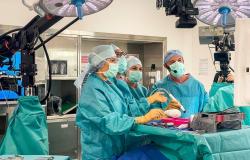
Certain cancer treatments cause early menopause, the symptoms of which are sometimes more intense than in the case of natural menopause. To overcome this, a non-drug procedure exists: subcutaneous ovarian tissue transplantation. Dr. Piver, surgeon, explains everything about this still little-known procedure.
WHAT YOU MUST REMEMBER :
– In the event of early menopause caused by cancer treatments, an ovarian tissue transplant (taken and frozen before treatments) is possible
– This graft is implanted subcutaneously
– The transplanted ovarian tissue begins to produce sex hormones after a few months and helps restore a natural hormonal cycle
– The duration of production of these hormones depends on the quality of the frozen tissue
Before any cancer treatment, women under 40 are offered different solutions to preserve their fertility. Among these, cryopreservation of ovarian tissue consists of removing an ovary and freezing fragments of it. After treatments, women who want to have a child can have the frozen tissue transplanted to be able to produce eggs again and have a chance of becoming pregnant.
But ovarian tissue does not only have a reproductive function. He also has a functionsaid endocrine, production of hormones, notably estrogen and progesterone. By grafting ovarian tissue into a woman who has gone through menopause due to treatments, it is therefore possible to restore this function and allow her to return to a natural hormonal cycle, and avoid hormone replacement treatment.
Ovarian tissue transplantation has only been authorized for this indication since the latest bioethics law of 2021. It is therefore still little known. Dr Pascal Piver, surgeon at Limoges University Hospital, has trained many of his colleagues to make it accessible to everyone. He explains to us what it consists of and who can benefit from it.
Is the procedure of transplanting ovarian tissue with the aim of restoring hormone production different from that intended to restore fertility?
Dr Pascal Piver: Yes. In a fertility context, the tissue must be re-implanted at the natural site, on or near the ovary, so that the oocytes it will produce can be collected by the tube and have a chance of being fertilized. This is called an orthotopic transplant. This procedure is done under laparoscopy.
When the transplant is carried out to restore endocrine function, we do not have this constraint. It can therefore be heterotopic, that is to say be located elsewhere.
Can we transplant ovarian tissue anywhere?
Theoretically, yes. To avoid a major intervention, the graft is most often carried out subcutaneously, under local anesthesia.
You should know that, every month, during the follicular phase, the tissue will swell and a small ball will appear at the implantation site. As this can be inconvenient for patients, we discuss with them the best place to place it. This could be in the abdomen, for example, or under the arm.
How long does it take for the cycles to resume?
The procedure works in 85% of cases and endocrine function generally returns after 3 to 6 months. This is the time necessary for the tissue to revascularize, for the follicles to resume growth and for them to produce hormones.
How long does the effect last?
This depends on the condition of the tissue at the time of collection. If the woman was taken when she was young and her reproductive cell stock was good, we can hope that the cycles will continue for several years. One of my patients kept cycles for 8 years.
When the graft stops working, the procedure can be repeated with the other frozen fragments, if any.
Until what age can you benefit from an ovarian tissue transplant?
When carried out with the aim of restoring endocrine function, the transplant can be carried out up to 50 years of age.
When is it contraindicated?
The transplant is contraindicated if there is a risk that the ovarian tissue contains cancer cells and therefore, of re-implantation of the disease.
Women on hormonal therapy cannot benefit from it either since restoring their endocrine function would go against their treatment which aims precisely to block the production of sexual hormones.
Is this procedure accessible to all women, regardless of where they live in France?
Yes. Since the beginning at Limoges University Hospital, our goal has been to democratize this procedure. This is the case today: there are fertility preservation centers authorized to perform this procedure throughout France.
Doctor of biology, science journalist and editor-in-chief of the Rose magazine website
- -




